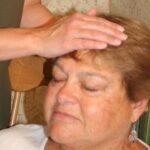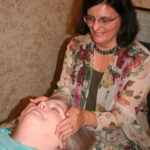Reiki in A Long-Term Care Environment
“Your hands are so warm; they feel so good. It feels soft. I feel good all over!” What’s this? In a long term care center? It’s Reiki!
At Mary Immaculate Nursing/Restorative Care Center, Inc. in Lawrence, Massachusetts residents may receive Reiki through a grant funded activities program called, “Beyond Bingo.” Initially begun to provide activity and sensory stimulation to those residents who do not engage in group activities, the staff of Mary Immaculate has noticed far greater outcomes. I have the honor of being one of the Reiki professionals serving the residents of Mary Immaculate.
What is Reiki?
Reiki is a complementary care modality, meaning that it works well with conventional health care. The word Reiki means “Universal Life Force Energy” in Japanese. Each person has energy; depending on your school of thought, your energy moves through chakras or meridians. Well being is experienced when energy is flowing freely, in balance, and in the proper amount. Dis-ease occurs when a person’s energy flow is blocked, depleted, or out of balance.
Easy to learn and simple to do, Reiki and the concept of energy is new to some health care professionals. However, Reiki has been around for nearly a hundred years. Founded by Dr. Usui in Japan, the knowledge traveled to the United States in 1940 through Hawayo Takata, a Japanese-American woman living in Hawaii. Reiki is practiced in acute care, long term care, hospice, and many other healthcare settings. In Massachusetts, the Board of Nursing has determined that, “Nurses may employee complementary therapies as part of an overall plan of care for which clients have granted informed consent.” Reiki is specifically listed as a complementary therapy in Advisory Ruling 9801 titled, “Holistic Nursing and Complementary Therapies.”
Integrating Reiki into Long Term Care
At Mary Immaculate, each resident or their power-of-attorney received a letter and informed consent form. Nearly 100% were signed and returned. Because of grant funding from the Pringle Foundation and the Rogers Foundation, there is no cost to residents.
Deb Smith, Director of Activities, hired Reiki professionals as independent contractors. All went through a credentialing process. Assignments come through the Activities Department, with input from all departments following the daily interdepartmental leadership meeting.
As a registered nurse, I provide Reiki within the nursing process. I assess each resident and make nursing diagnoses. Together, the resident and I agree upon a plan, which is implemented and evaluated. Generally, a short seated Reiki session is performed in 10 to 20 minutes. Hand positions are modified, depending on my assessment and patient preference. Patients receive Reiki wherever they happen to be; in bed, while sitting in their wheelchair, or while sitting in an easy chair.
Outcome Data
Each resident who received Reiki engaged in meaningful activity. Residents focused on, contributed to, or showed enjoyment in receiving Reiki, and/or showed delight in the results. Nonverbal indicators include resting or leaning into my hands, holding and/or squeezing my hands, smiling, shifting posture from leaning forward to resting back in the chair, and deep sighs. Verbal responses include saying “I feel good,” “I feel peaceful,” “I feel alrighty,” and “It calmed me.”
Each Reiki session resulted in energy field balance. I observe changes in energy flow manifested by temperature, visual images, or movement. Often, energy flow is not noticed by those receiving Reiki. Those who do sense Reiki energy notice it as a feeling of warmth or tingling from the Reiki person’s hands. Residents occasionally comment on energy flow, saying “My leg feels warm now,” or “Your hands feel so warm!”
Reduction in anxiety behaviors was significant in residents who exhibited anxiety prior to Reiki. (92%) Behaviors such as restlessness, fidgeting, irritability, and agitation decreased during Reiki.
Seventy-seven percent of patients exhibited increased comfort, relief of pain, relaxation, and/or an increased sense of wellbeing. Observations included relaxed muscle tone, slowed or deepened respirations, and changes in facial expression. Verbal responses included, “that’s better,” “That feels good,” and “It really helped.”
This outcome data was collected from thirty-nine Reiki sessions provided from October through December of 2007.
Learning Reiki
Both lay people and healthcare professionals can learn Reiki. The first step, Reiki Level One, is often taught in a one-day class and prepares the students to do Reiki on themselves. Reiki Level Two and Reiki Level Three, advanced classes, expand the knowledge and techniques available to the Reiki giver. To be a teacher, one must attain the level of Reiki Master-Teacher, often including an internship. At Mary Immaculate Nursing/Restorative Care Center, I teach Reiki Level One and Two to the staff. The goal of staff education is to give them a technique they can use to care for themselves, and to expand the number of people available who can offer Reiki to the residents.
Conclusion
Reiki, a complementary care form of energy medicine, is a valued addition to the care of residents at Mary Immaculate Nursing/Restorative Care Center. Residents engage in meaningful activity, and experience a number of wellness benefits. Fortunately funding for this program has been extended by private donations from friends and family of residents, and by additional grant funding.
Previously published in Healthcare Review, April 21 to May 27, 2008, Vol. 21, Issue 4



One Comment
Comments are closed.